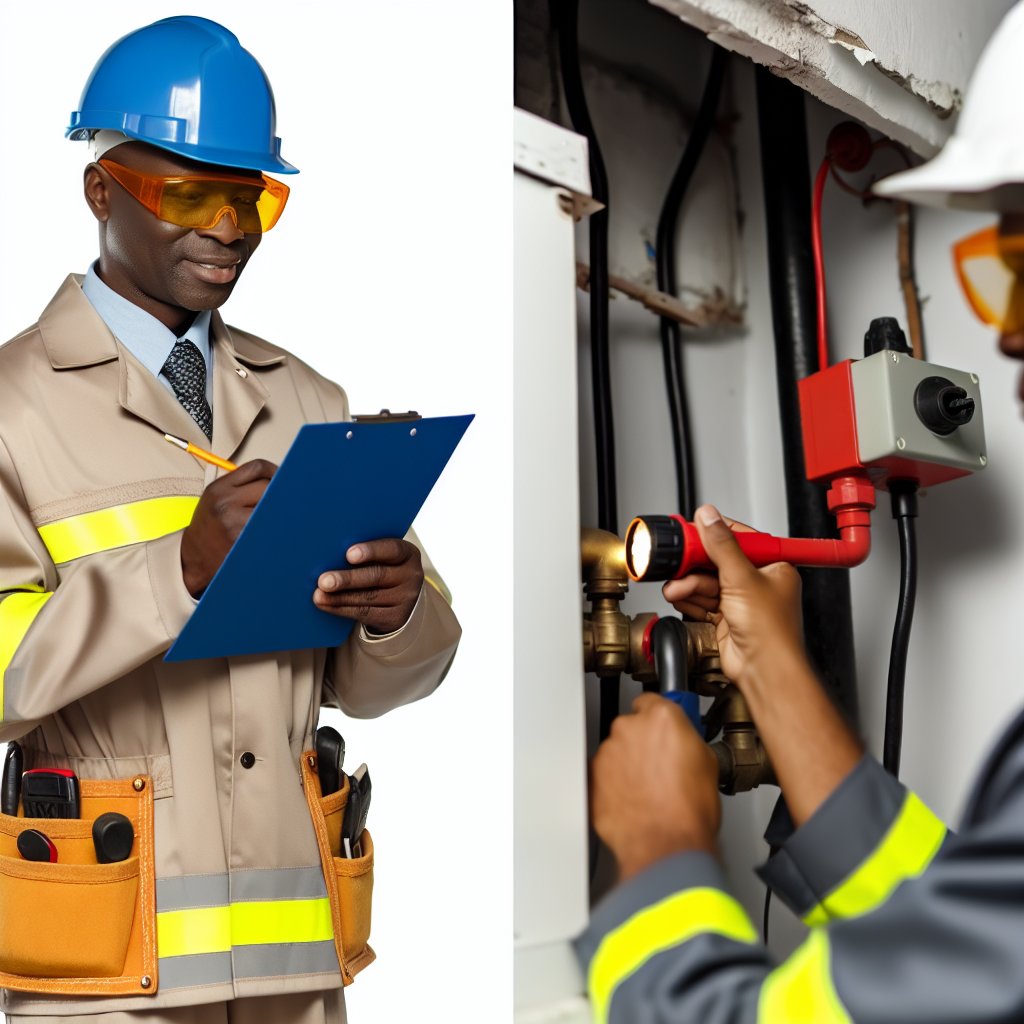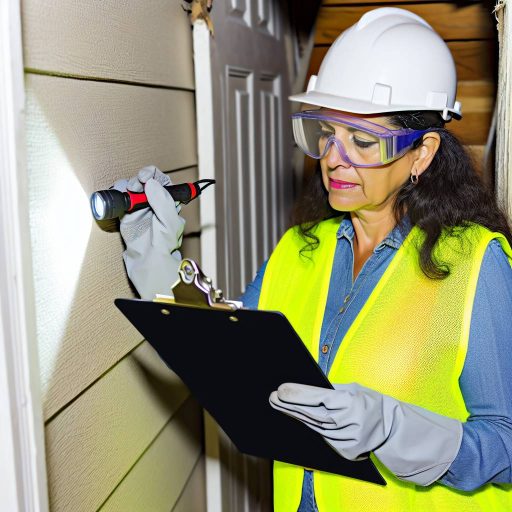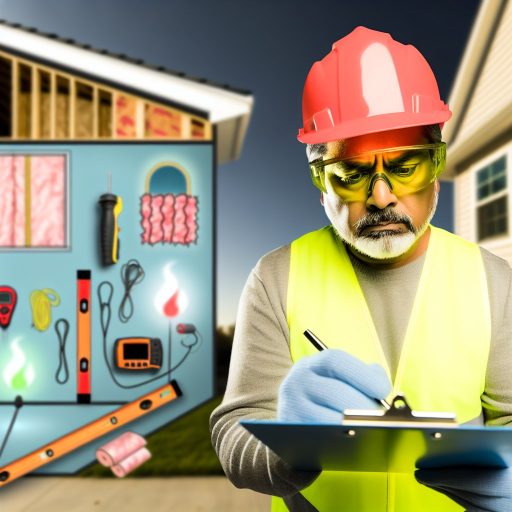Introduction to Plumbing and Electrical Systems in Home Inspections
Home inspections cover various critical systems, particularly plumbing and electrical.
These systems significantly impact safety and functionality in your home.
Understanding their importance helps homeowners make informed decisions.
In this section, we will explore essential insights about these systems.
Overview of Plumbing Systems
Plumbing systems are vital for water supply and waste removal.
They include pipes, fixtures, and appliances that deliver water.
In addition, they dispose of wastewater properly.
Regular inspection helps prevent leaks and other issues.
Common plumbing problems may lead to extensive damage if neglected.
Key Components of Plumbing
- Pipes and fittings transport water throughout the home.
- Fixtures include sinks, tubs, and toilets.
- Water heaters provide hot water for daily needs.
- Sewage systems handle wastewater safely.
Signs of Plumbing Issues
Watch for signs indicating plumbing problems in your home.
Leaking pipes can cause water damage and mold growth.
Low water pressure may suggest clogs or leaks.
Unpleasant odors could indicate issues with sewage lines.
Regular maintenance prevents major plumbing failures.
Overview of Electrical Systems
Electrical systems power your home and appliances.
Transform Your Real Estate Decisions
Unlock personalized real estate insights crafted just for you. Get actionable advice designed to amplify your success.
Get StartedThey include wiring, outlets, and circuit breakers.
Proper functioning of electrical systems is crucial for safety.
Regular inspections help identify potential hazards.
Outdated wiring can pose a fire risk.
Key Components of Electrical Systems
- Wiring distributes electricity throughout the home.
- Outlets provide access to electrical power.
- Fuse boxes and circuit breakers protect your home from overload.
- Grounding systems ensure safe operation of electrical devices.
Signs of Electrical Issues
Be aware of indicators of electrical problems in your home.
Flickering lights may indicate circuit issues or overloaded circuits.
Burning smells can suggest electrical shorts or overheating.
Tripped breakers may point to faults in the electrical system.
Prompt attention to these issues ensures safety and functionality.
Essential Plumbing Components to Inspect
Pipes and Fixtures
Inspect all visible pipes for leaks or corrosion.
Check faucets for drips and ensure smooth operation.
Examine toilets for proper flushing and leaks.
Verify that showerheads provide adequate water flow.
Inspect sinks for proper drainage and visible cracks.
Showcase Your Real Estate Business
Publish your company profile on our blog for just $200. Gain instant exposure and connect with a dedicated audience of real estate professionals and enthusiasts.
Publish Your ProfileWater Heater
Evaluate the age of the water heater for potential replacement.
Inspect for signs of rust or leakage around the unit.
Check the temperature setting for safety and efficiency.
Ensure proper ventilation for gas water heaters.
Main Water Supply Line
Locate the main water shut-off valve for emergency use.
Inspect the line for signs of wear or leaks.
Ensure it’s easily accessible for quick shut-off.
Sewage System
Check for proper functioning of all sewer lines.
Inspect clean-out access points for blockages.
Look for signs of backflow or sewer gas odors.
Consider a camera inspection for older systems.
Drainage and Sump Pumps
Ensure all drains are flowing freely without obstruction.
Examine sump pumps for functionality and proper installation.
Test battery backup systems if applicable.
Check for any signs of water accumulation in basements.
Key Electrical Systems to Evaluate During Inspections
Main Electrical Supply
The main electrical supply is the heart of your home’s electrical system.
Inspect the capacity of the main service panel.
Ensure it meets the electrical needs of your home.
Look for signs of wear or damage on the panel.
Additionally, verify that circuit breakers are functioning correctly.
Wiring Condition
Wiring condition significantly impacts your home’s safety.
Examine all visible wiring for fraying or excessive wear.
Cables should have proper insulation and not show any signs of damage.
Check for outdated wiring types, such as knob-and-tube systems.
These can be fire hazards and require immediate attention.
Outlets and Switches
Evaluate the condition of all electrical outlets and switches.
Ensure they are securely mounted and functional.
Check for signs of overheating or discoloration.
Ground fault circuit interrupters (GFCIs) should be present in wet areas.
Verify that all outlets are correctly wired and grounded.
Showcase Your Real Estate Business
Publish your company profile on our blog for just $200. Gain instant exposure and connect with a dedicated audience of real estate professionals and enthusiasts.
Publish Your ProfileLighting Fixtures
Inspect all lighting fixtures throughout your home.
Check for proper installation and secure mounting.
Look for signs of burning or overheating bulbs.
Ensure that light switches control the intended fixtures.
Replace any burned-out bulbs during your inspection.
Smoke and Carbon Monoxide Detectors
Smoke and carbon monoxide detectors safeguard your home.
Check that these detectors are present in key areas.
Test each unit to ensure proper functionality.
Replace batteries annually or as needed for reliability.
Consider installing additional detectors for enhanced safety.
Surge Protection
Surge protection devices minimize the risk of electrical surges.
Check for whole-house surge protectors at the panel.
Additionally, consider surge protectors for sensitive electronics.
Ensure these devices are functioning and properly rated.
This prevents damage to your appliances and electronics.
Electrical Service Upgrades
Consider if your electrical service needs upgrades.
As homes age, electrical needs often exceed original capacities.
Consult a licensed electrician for a professional assessment.
This evaluation helps identify any deficiencies in service.
Upgrading can improve efficiency and safety in your home.
See Related Content: The Role Of Homeowners Insurance For First-Time Homebuyers Explained
Common Plumbing Issues Found in Home Inspections
Leaky Pipes
Leaky pipes are a frequent issue found during home inspections.
They can arise from corrosion, loose connections, or wear and tear.
Inspectors typically look for signs of water damage near plumbing fixtures.
It is essential to address leaks promptly to prevent further damage.
Clogged Drains
Clogged drains are another common finding in residential plumbing systems.
Blockages often occur due to hair, grease, or soap buildup.
Inspectors may use cameras to identify the location of the clog.
Clearing these clogs can restore proper drainage in the home.
Water Heater Problems
Water heaters may exhibit several issues during an inspection.
Showcase Your Real Estate Business
Publish your company profile on our blog for just $200. Gain instant exposure and connect with a dedicated audience of real estate professionals and enthusiasts.
Publish Your ProfileCommon problems include leaks, insufficient hot water, and unusual noises.
Inspectors check for corrosion on the tank and ensure proper venting.
Regular maintenance can prolong the life of a water heater.
Running Toilets
A running toilet can waste significant amounts of water.
This issue often results from faulty flappers or fill valves.
Inspectors test toilets to determine if they are functioning correctly.
Fixing a running toilet can help save on water bills.
Pipe Insulation Issues
Improperly insulated pipes can lead to frozen or burst pipes in colder climates.
Inspectors evaluate insulation around exposed pipes in unheated areas.
Upgrading insulation can prevent costly repairs in the winter months.
Older Plumbing Systems
Homes with older plumbing systems may face unique challenges.
Galvanized pipes, for instance, can corrode and reduce water pressure.
Inspectors assess the plumbing materials used throughout the home.
Upgrading outdated systems can improve efficiency and safety.
You Might Also Like: Preparing Financially For Your First Home Purchase In The USA
Frequent Electrical Problems Encountered in Homes
Overloaded Circuits
Overloaded circuits occur when too many devices draw power simultaneously.
This can lead to tripped breakers and possible electrical fires.
Inspect your circuit breakers to ensure they are functioning correctly.
Faulty Outlets
Faulty outlets can cause appliances to malfunction.
Additionally, they may pose a fire hazard if not addressed promptly.
Check for loose connections and burnt marks around the outlets.
Flickering Lights
Flickering lights may indicate a loose bulb or wiring issue.
Inconsistent lighting can also stem from a failing switch.
Ensure all bulbs are securely installed and functioning properly.
Power Surges
Power surges can damage electronics and appliances.
Common causes include lightning strikes and faulty wiring.
Consult an electrician to install surge protectors if needed.
Old Wiring
Older homes may have outdated wiring that needs replacement.
This can lead to increased risks of electrical fires and shocks.
Schedule an inspection if your home has wiring older than 30 years.
Showcase Your Real Estate Business
Publish your company profile on our blog for just $200. Gain instant exposure and connect with a dedicated audience of real estate professionals and enthusiasts.
Publish Your ProfileInsufficient Grounding
Insufficient grounding can lead to electrical shocks and appliance failures.
Ensure all outlets, especially in wet areas, are correctly grounded.
This is crucial for protecting both residents and devices.
Exposed Wires
Exposed wires are a direct safety hazard in any home.
Animals or humans can easily come into contact with them.
Address any visible wiring issues immediately to prevent accidents.
Explore Further: Home Inspection Checklist For Spotting Foundation Issues

Importance of Checking for Code Compliance in Plumbing and Electrical Systems
Ensuring Safety and Functionality
Code compliance in plumbing and electrical systems ensures safety in your home.
This compliance protects against potential hazards like fire or flooding.
Moreover, it guarantees that systems function as intended.
Annual inspections can help identify issues before they escalate.
Avoiding Costly Repairs
Identifying code violations early can save homeowners significant costs.
Repairing non-compliant systems can prevent emergencies and additional damage.
In some cases, local laws may require upgrades to meet current standards.
Addressing these issues promptly avoids financial strain down the line.
Enhancing Property Value
Compliance with local codes positively impacts your home’s value.
Potential buyers prefer homes without plumbing or electrical issues.
An inspection can help document compliance for prospective buyers.
Additionally, it instills confidence in the safety and functionality of the home.
Meeting Local Regulations
Every region has specific plumbing and electrical codes to follow.
These codes are designed to ensure public safety and welfare.
Familiarizing yourself with local regulations is vital for homeowners.
Consulting a licensed inspector can provide clarity on compliance issues.
Promoting Environmental Responsibility
Code compliance often includes energy efficiency standards.
Upgrading systems can reduce your environmental footprint.
Moreover, compliant systems typically use resources more conservatively.
This approach not only helps the planet but can also lower utility bills.
Delve into the Subject: Home Inspection Checklist For Evaluating Plumbing Systems In Homes
Tips for Homeowners: How to Prepare for a Plumbing and Electrical Inspection
Understanding the Importance of Inspections
Inspecting plumbing and electrical systems protects your home’s functionality.
Regular inspections can prevent costly repairs in the future.
Showcase Your Real Estate Business
Publish your company profile on our blog for just $200. Gain instant exposure and connect with a dedicated audience of real estate professionals and enthusiasts.
Publish Your ProfileAlso, they ensure safety for you and your family.
Gather Necessary Documentation
Start by locating your home’s blueprints or diagrams.
These documents show the layout of plumbing and electrical systems.
Also, keep previous inspection reports handy for reference.
Finally, gather warranties for appliances or systems that might be inspected.
Identify Potential Problem Areas
Walk through your home to check for visible issues.
Look for leaks under sinks and signs of water damage on walls.
Also, inspect for faulty wiring or exposed electrical components.
Being proactive can lead to safer and more efficient repairs.
Make Repairs Ahead of Time
Fix any minor leaks or drips in your plumbing system.
Check for loose connections in your electrical fixtures.
Addressing small issues can improve inspection outcomes dramatically.
If needed, hire a licensed professional for complex repairs.
Prepare Your Home for the Inspector
Clear access to all plumbing and electrical areas.
Remove furniture blocking access to outlets or pipes.
Ensure the inspector can easily examine all relevant systems.
Ask Questions During the Inspection
Engage with the inspector while they work.
Ask them to explain any findings or recommendations.
Understanding their insights can help you prioritize repairs.
Furthermore, take notes for future reference.
Follow Up on Recommendations
After the inspection, review the report thoroughly.
Address any issues the inspector highlighted quickly.
Contact licensed professionals for repairs recommended.
Taking action promptly ensures your home remains safe and functional.
Summary of Tools Needed for Inspecting Plumbing and Electrical Systems
Essential Plumbing Inspection Tools
Start with a flashlight to enhance visibility in dark areas.
A pipe wrench helps adjust and tighten plumbing fixtures.
Use a plunger to test the effectiveness of drains.
Include a pipe inspection camera for hard-to-reach areas.
A moisture meter detects leaks and dampness effectively.
Carry a pressure gauge to check water pressure accurately.
Showcase Your Real Estate Business
Publish your company profile on our blog for just $200. Gain instant exposure and connect with a dedicated audience of real estate professionals and enthusiasts.
Publish Your ProfileLastly, a utility knife can cut through plumbing access points.
Key Electrical Inspection Tools
Begin with a multimeter to measure voltage, current, and resistance.
An insulated screwdriver set assures safety while working on circuits.
Use a circuit tester to identify live wires easily.
Digital clamp meters are ideal for measuring electrical current.
Wire strippers facilitate the preparation of wires for connections.
Safety goggles provide protection during electrical inspections.
Consider a voltage tester to confirm power is off before work.
General Tools for Both Systems
Wear appropriate safety gear, including gloves and hard hats.
A notepad helps record findings during inspections.
Fieldwork often requires a level to ensure installations are even.
Additionally, use a toolbox to keep all tools organized.
Finally, ensure you have a ladder to reach high fixtures safely.
Additional Resources
Tips/regrets on buying an old house? : r/homeowners
What Do Home Inspectors Look For? What’s Included and What’s Not?




